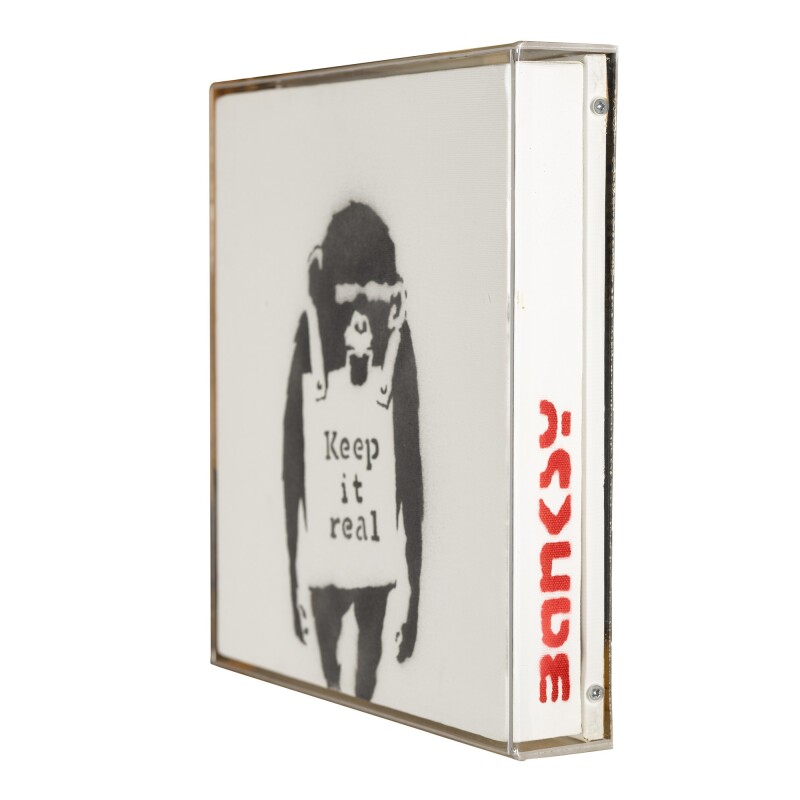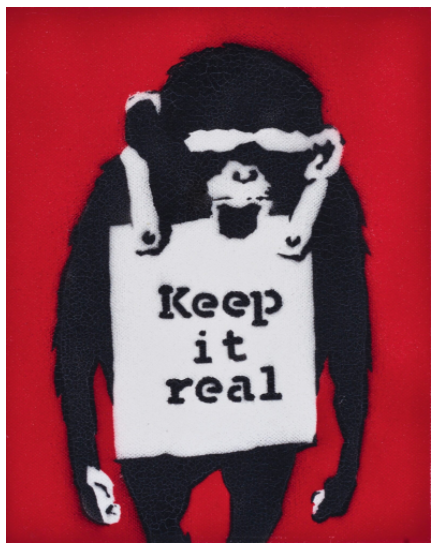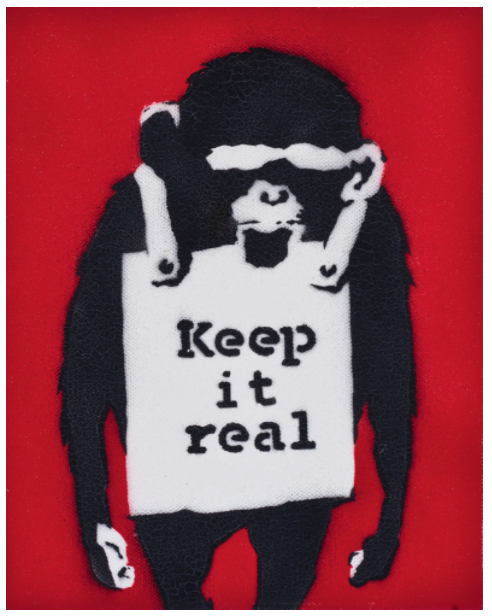Stencil spray-paint and acrylic on canvas
25×20 cm (8 1/8 x 7 7/8 inches)
Inscribed with Banksy’s signature on the overlap
Numbered /15 on the reverse

Edition: 15
Acrylic and spray paint on canvas
30.5 x 30.5 cm (12×12 inches)
Stenciled with the artist’s signature on the overturn edge
Numbered on the stretcher


From its first iteration, Banksy has mobilized the figure of the monkey with all its Darwinian associations of docility, inferiority and intellectual simplicity, as the perfect visual representation of the subordination of the masses. In this light, Keep it Real, can be understood as a critique of the authoritarian manipulation of the working class, despondent and suppressed under the forces of capitalism. Conversely Banksy’s chimpanzees, rather than inhabiting a purely docile existence, may also be seen as deviant and mischievous clever characters. It is through this duality of association, that the monkey has taken centre stage in Banksy’s practice as one of the most widely recognizable motifs in the artist’s arsenal through which to represent both the dejected and disillusioned masses and the authoritarian figures of the establishment. From the earliest Monkey Detonator through to works that directly mock the establishment, notably the ambitious dystopian reimagining of the House of Commons run amok with irate chimps (Devolved Parliament, 2009), primates are Banksy’s most frequently called-upon symbol, as a means through which to mock and challenge perceived authority and the establishment. Indeed, the figure of the chimpanzee has remained central in the decades succeeding its inception. Considering Banksy’s mature practice, author Patrick Potter has stated, “These images can be really arresting at their best. They’ve evolved from the kind of cartoonish carnival of Banksy’s animal army to controlled irony, designed to reveal the foolishness hidden in plain view in our society’s values” (Patrick Potter, Banksy: You are an acceptable level of threat and if you were not you would know about it, Durham 2012, n.p.).

It is this distinctive cutting social commentary and political undertone that has underpinned Banksy’s position as one of the most important artists of our time and garnered his cult-like following. Mobilizing a longstanding tradition of social satire and visual parody, Banksy has inherited the role of the British pictorial satirists in the contemporary sphere, following in the distinctly unapologetic footsteps of the likes of William Hogarth to penetrate public consciousness and challenge the role of the establishment. Banksy’s finest work is situated within an esteemed tradition of raising an unforgiving and illuminating mirror up to the world. With his dark humor and subversive epigrams, Banksy perfectly encapsulated his defiantly anti-authoritarian stance with the maxim: “Art should comfort the disturbed and disturb the comfortable” – a contemporary take on the turn-of-the-century American satirist Finley Peter Dunne’s declaration that the duty of a newspaper is to “comfort the afflicted and afflict the comfortable” (Finley Peter Dunne cited in: Dean P. Turnbloom, Ed., Prizewinning Political Cartoons, Gretna 2010, p. 146). It is Banksy’s uncanny ability to translate complicated socio-political commentary into striking, highly legible images presented for the public, in public. Lauren Collins noted in The New Yorker that: “[…] Banksy is able to achieve a meticulous level of detail. His aesthetic is clean and instantly readable-broad social cartooning rendered with the graphic bang of an indie concert poster” (Lauren Collins, ‘Banksy Was Here,’ The New Yorker, 14 May 2007, online).

Despite the cynical puns, witty punchlines, and an espousal of anti-taste and shock tactics, there is a sense of ambiguity that more often than not authentically challenges issues concerning representation and power structures in contemporary life. This is what makes his work so fascinating, appealing, and ultimately so enduring.
Auction Results

Keep It Real, 2002
Acrylic and spray paint on canvas
30.5 x 30.5 cm (12×12 inches)
Edition: 15
Stenciled with the artist’s signature on the overturn edge
Numbered 10/15 on the stretcher
GBP 499,000





